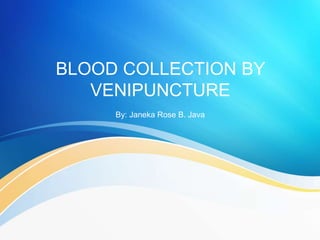
BLOOD COLLECTION BY VENIPUNCTURE.ppt
- 1. BLOOD COLLECTION BY VENIPUNCTURE By: Janeka Rose B. Java
- 2. • Blood is obtained from veins, arteries or capillaries • Venous blood- specimen of choice in chemistry procedures (Venipuncture) • Phlebotomy- process of collecting the blood sample by a trained phlebotomist
- 3. • Samples that can be obtained after collection: – whole blood – plasma or serum
- 4. VENIPUNCTURE • procedure of inserting a needle into a vein • purpose of withdrawing blood for – haematological analysis – biochemical analysis – bacteriological analysis
- 6. MEDICAL ETHICS 1.Professional appearance personal cleanliness good grooming 2.Professional attitude and interpersonal skills 3.Patient confidentiality
- 7. PROCEDURE 1.Patient greeting and identification • conduct themselves in a professional manner • be courteous and respectful • introduce self and explain test/s ordered by physician if patient is conscious • let patient state his/her name and spell any unusual name • never ask yes/no questions
- 8. 2. Note patient-isolation restrictions • for patients that have contagious conditions or infections • for patients that must be protected from employees or visitors (immunosuppressed patients)
- 9. 3. Note patient-dietary restrictions • glucose is affected by diet so fasting is required • fasting should be done and for the right length of time
- 10. 4. Reassure the patient • collector's reassuring approach should be calm but confident to relieve patient's anxiety over the pain from the collection • collector should be honest
- 11. 5. Position the patient • patient position can affect analyte values • erect posture increases concentration of some analytes • keep arm below shoulder level, extending downward, keeping it straight (sitting) • if lying down, patient should remain in his/her back and extend arm fully outward the side • pillow or patient's opposite fist can be used as support
- 12. 6. Assemble supplies • assemble sterile needle and syringe aseptically • Gauge 20 and 21- forearm • Gauge 23- wrist and ankle • syringe depends on amount of blood required • move plunger up and down attempting to force air through the needle *verify paperwork, select collection tubes and venipuncture location
- 13. 7. Apply torniquet and ask patient to close hand • vein becomes more prominent • never leave torniquet on arm for more than two minutes • tourniquet should be placed 3-4 inches above puncture site
- 14. 8. Select venipuncture site • inspect both arms to locate best veins • use fingertips to gently press veins - determine direction - estimate size • palpate to determine • vein- pliable • tendon or muscle- hard • artery- pulsate
- 15. 9. Cleanse the site • clean site with cotton moistened with 70% ethyl alcohol by making outward concentric circles • air dry *once the site it cleansed, it must not be touched; if touched after cleaning, site must be cleansed again
- 16. 10. Inspect needle and syringe • check for hooks or obstruction of opening the tip • pull plunger back and forth to ensure smooth motion
- 17. 11. Anchor the vein • place thumb 2-3cm below the puncture site • pull the skin while grasping the arm with the other four fingers
- 18. 12. Perform venipuncture • inserting the needle -hold syringe in the right hand -grasp patient's arm with the left hand -place thumb 2-3cm below the puncture site -do not touch the sterile needle -make sure bevel of the needle is facing upward -insert needle with a quick steady motion through the skin and into the vein
- 19. • withdrawing the blood • exert gentle traction -blood should flow freely, if not, needle must have been pushed too far -if blood cannot be obtained directly, withdraw the needle • apply pressure on the patient's arm • withdraw blood gently to avoid frothing -frothing can be minimized if plunger is rotated
- 20. 13. Release torniquet and ask patient to open hand • if desired amount is obtained, release torniquet • place sterile gauze or cotton to the site of entry and withdraw the needle
- 21. 14. Remove needle and apply pressure • apply pressure to the patient's arm to prevent bleeding • any bleeding will stop in 1-2 minutes
- 22. 15. Processing the collected sample • slowly expel blood into the container • tilt the container so that blood will run down the side • stop transfer when nothing but froth remains in the syringe • immediately remove plunger and place in detergent/disinfectant solution • label tubes • patient's surname, first name, and middle • date and time, and initials of phlebotomist *automated systems may include labels with bar codes
- 23. ORDER OF DRAW 1. Yellow • Citrate dextrose • Blood culture 2. Blue • Buffered citrate • Coagulation assay (APTT & PT) 3. Red • Non-additive tube • Chemistry and serology
- 24. 4. Green • Heparin • Blood gas 5. Lavender • EDTA • Hematologic assays 6. Grey • Sodium Fluoride & Potassium oxalate • Glucose determination
- 25. AREAS TO AVOID • Intravenous therapy • Edematous area • Burned, scarred areas • Upper extremity on the side of previous mastectomy • Areas with hematoma
- 26. SOURCES OF ERROR 1. Improper patient identification 2. Failure to check patient adherence to dietary restrictions 3. Use of improper equipment/tubes 4. Prolonged torniquet application 5. Failure to dry site after cleansing 6. Inserting needle with bevel down 7. Wrong insertion depth of needle 8. Venipuncture above the intravenous line
- 27. 9. Venipuncture in an unacceptable area 10. Incomplete tube filling 11. Vigorous shaking/hemolysis of specimens 12. Neglecting to release torniquet before needle withdrawal 13. Mislabeling of tubes 14. Failure to put initials, date and time 15. Neglecting to chill specimens requiring refrigeration 16. Slow transport of specimens to the laboratory